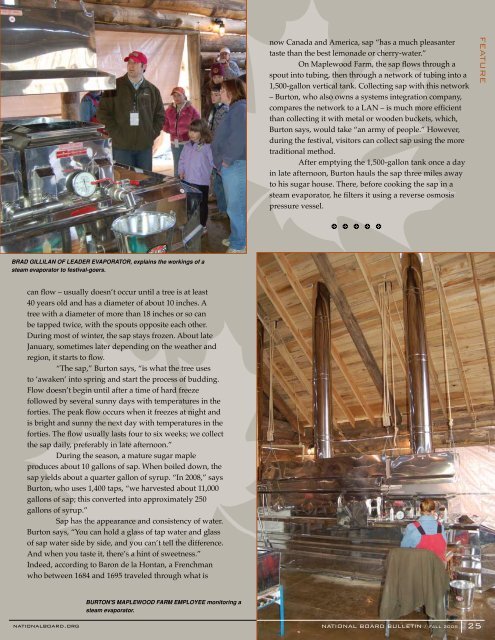to view a PDF of the - National Maple Syrup Festival
to view a PDF of the - National Maple Syrup Festival
to view a PDF of the - National Maple Syrup Festival
You also want an ePaper? Increase the reach of your titles
YUMPU automatically turns print PDFs into web optimized ePapers that Google loves.
BRAD GILLILAN OF LEADER EVAPORATOR, explains <strong>the</strong> workings <strong>of</strong> a<br />
steam evapora<strong>to</strong>r <strong>to</strong> festival-goers.<br />
can flow – usually doesn’t occur until a tree is at least<br />
40 years old and has a diameter <strong>of</strong> about 10 inches. A<br />
tree with a diameter <strong>of</strong> more than 18 inches or so can<br />
be tapped twice, with <strong>the</strong> spouts opposite each o<strong>the</strong>r.<br />
During most <strong>of</strong> winter, <strong>the</strong> sap stays frozen. About late<br />
January, sometimes later depending on <strong>the</strong> wea<strong>the</strong>r and<br />
region, it starts <strong>to</strong> flow.<br />
“The sap,” Bur<strong>to</strong>n says, “is what <strong>the</strong> tree uses<br />
<strong>to</strong> ‘awaken’ in<strong>to</strong> spring and start <strong>the</strong> process <strong>of</strong> budding.<br />
Flow doesn’t begin until after a time <strong>of</strong> hard freeze<br />
followed by several sunny days with temperatures in <strong>the</strong><br />
forties. The peak flow occurs when it freezes at night and<br />
is bright and sunny <strong>the</strong> next day with temperatures in <strong>the</strong><br />
forties. The flow usually lasts four <strong>to</strong> six weeks; we collect<br />
<strong>the</strong> sap daily, preferably in late afternoon.”<br />
During <strong>the</strong> season, a mature sugar maple<br />
produces about 10 gallons <strong>of</strong> sap. When boiled down, <strong>the</strong><br />
sap yields about a quarter gallon <strong>of</strong> syrup. “In 2008,” says<br />
Bur<strong>to</strong>n, who uses 1,400 taps, “we harvested about 11,000<br />
gallons <strong>of</strong> sap; this converted in<strong>to</strong> approximately 250<br />
gallons <strong>of</strong> syrup.”<br />
Sap has <strong>the</strong> appearance and consistency <strong>of</strong> water.<br />
Bur<strong>to</strong>n says, “You can hold a glass <strong>of</strong> tap water and glass<br />
<strong>of</strong> sap water side by side, and you can’t tell <strong>the</strong> difference.<br />
And when you taste it, <strong>the</strong>re’s a hint <strong>of</strong> sweetness.”<br />
Indeed, according <strong>to</strong> Baron de la Hontan, a Frenchman<br />
who between 1684 and 1695 traveled through what is<br />
nationalboard.org<br />
BURTON'S MAPLEWOOD FARM EMPLOYEE moni<strong>to</strong>ring a<br />
steam evapora<strong>to</strong>r.<br />
now Canada and America, sap “has a much pleasanter<br />
taste than <strong>the</strong> best lemonade or cherry-water.”<br />
On <strong>Maple</strong>wood Farm, <strong>the</strong> sap flows through a<br />
spout in<strong>to</strong> tubing, <strong>the</strong>n through a network <strong>of</strong> tubing in<strong>to</strong> a<br />
1,500-gallon vertical tank. Collecting sap with this network<br />
– Bur<strong>to</strong>n, who also owns a systems integration company,<br />
compares <strong>the</strong> network <strong>to</strong> a LAN – is much more efficient<br />
than collecting it with metal or wooden buckets, which,<br />
Bur<strong>to</strong>n says, would take “an army <strong>of</strong> people.” However,<br />
during <strong>the</strong> festival, visi<strong>to</strong>rs can collect sap using <strong>the</strong> more<br />
traditional method.<br />
After emptying <strong>the</strong> 1,500-gallon tank once a day<br />
in late afternoon, Bur<strong>to</strong>n hauls <strong>the</strong> sap three miles away<br />
<strong>to</strong> his sugar house. There, before cooking <strong>the</strong> sap in a<br />
steam evapora<strong>to</strong>r, he filters it using a reverse osmosis<br />
pressure vessel.<br />
NATIONAL BOARD BULLETIN / FALL 2008<br />
25<br />
FEATURE


